In a post-pandemic world coupled with a younger workforce, the look of the traditional office is changing as many businesses are either downsizing their space or reconfiguring it to fit a new generation of workers.
“Gen Z has very different expectations than baby boomers, Gen Xers and even millennials,” said Alysia Radicia, Partner at RDG Planning & Design. “They want more from their workplace than what’s historically been given, and because of how they experience the world, they are not shy about expressing those desires. This younger generation is far more focused on wellness spaces, fitness spaces and social spaces.”
One of the reasons for placing a greater emphasis on social spaces, Radicia said, is to reflect all the amenities people have from working at home. In order to compete with that, companies like Fusion Medical Staffing in west Omaha are putting in extras such as a coffee bar, a golf simulator and a selfie wall to promote office culture. Radicia has seen firsthand how the office culture is changing, as an interior designer for the Omaha area.
“We’ve also seen a greater emphasis on social spaces,” Radicia added. “Not just designing to bring employees into the workplace, but also while they’re there, creating ways for them to maximize time connecting and building relationships with co-workers.”

Radicia giving a tour of Fusion to the Omaha Board of Directors at the Waterford Building in west Omaha.
In the most recent edition of the Nebraska Economist, research indicates how the demand for residential and industrial space continues to climb, while the demand for office space has weakened with more people working from home than in the past.
Though office vacancy rates have gone up in Nebraska post-pandemic, they’ve increased more in bigger metropolitan areas across the nation. One reason may be related to regional differences in work-from-home policies.
“Even more than three years after the start of the pandemic, a consensus on remote/hybrid work policies has yet to emerge economy wide,” said Kansas City Fed Assistant Economist, John McCoy. “Ultimately, wherever remote/hybrid policies settle will have a major impact on trends in office real estate.”
Nebraska compared to the rest of the country
“Nebraska is lucky not to have the highs and lows experienced on the coasts,” said J.P. Raynor, broker for Investors Realty, Inc. “Midwest developers are conservative, so don’t flood the market with speculative buildings. Instead, developers wait for the demand to come to them and start construction on a building when the building is a minimum of 50% leased.”

J.P. Raynor with Investors Realty, Inc.
Raynor has worked in commercial real estate for close to twenty years in the Omaha area. He said the availability rate is higher than the vacancy rate in the Omaha area. Though similar, they measure different things. The vacancy rate is the percentage of all vacant commercial real estate space available for lease, while the availability rate is the percentage of all vacant commercial real estate space for lease or sale.
“Historically, Omaha had an availability rate of 6.7% with less than .2% of the rate being attributed to Available Sublease Space (approximately 106,936 sf),” Raynor said. “Since COVID-19, the availability rate has increased and remained above the pre-Covid rate until last quarter’s high of 9.8% with 1.9% of the rate attributed to Available Sublease Space (approximately 919,033 sf).”
Local businesses adjust to the hybrid workplace
Matt Hoover is the Head of BizOpps and Analytics at Breeze, an online disability insurance company based in Omaha. Breeze had a growth period during the pandemic and added more employees from remote locations. They discovered a remote and/or hybrid work environment had a lot more positives than negatives. All employees work from home during part of the work week.

Breeze employees in their new workspace downtown Omaha.
“Many companies learned during the pandemic that they could function as normal in a fully remote or hybrid environment,” he said. “Office space became a luxury versus a necessity. In our opinion, companies that can move to hybrid should move to hybrid. It’s better for families, the commute and accommodating diverse backgrounds.”
Hoover did admit that some of the most productive times were when employees were together in the office. However, he doesn’t foresee mandating people going into the office anytime soon, and they even designed the corporate office to be more versatile.
“Since we began hybrid, we intentionally designed our office space to be flexible with multiple work areas and breakout rooms for calls,” Hoover explained. “We had someone stop by and call it very ‘loungey’ which we are proud of, since we want our employees coming into the office to feel comfortable/at home when they’re here.”
Future forecast of office space in the region
So how will the future of the office space continue to evolve? Raynor said he’s noticed more employers want their employees back in the office post-Covid, but that also depends on the job.
“For example, businesses where collaboration is celebrated, and a part of everyday life will likely be back in the office at least 3 days per week, while back-office jobs where workflow is easily tracked may never return to the office,” he said.
Radicia said there will continue to be an emphasis on health and wellness, as well as a modern, digital spaces so work-from-home employees can feel just as comfortable as the in-office ones. Beyond that, it’s anyone’s guess.
“In the end, it’s all about retaining talent,” she said. “More employees working from home often means less relationship-building, and in the absence of this deeper, person-to-person connection to the work, employers must work even harder to build and maintain loyalty.”
